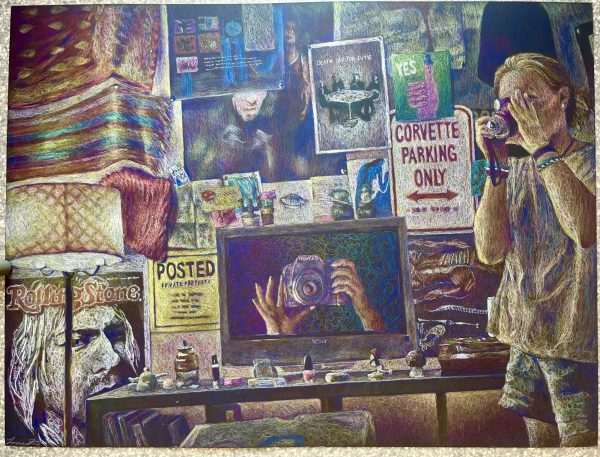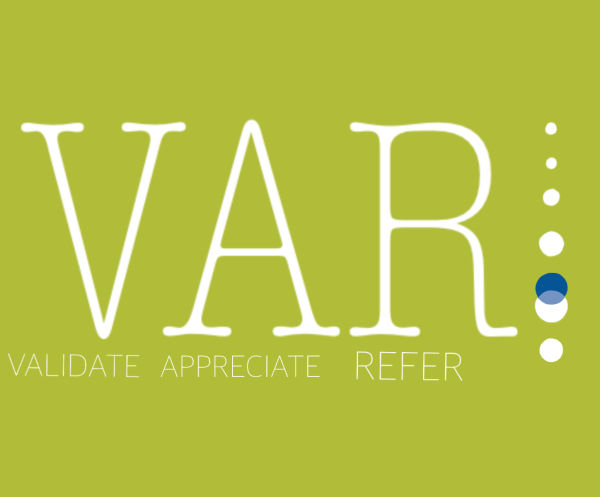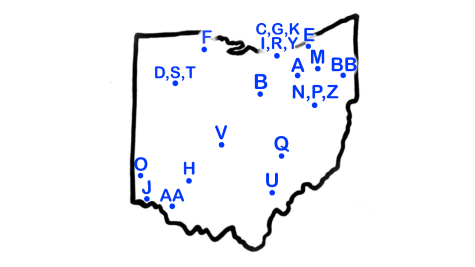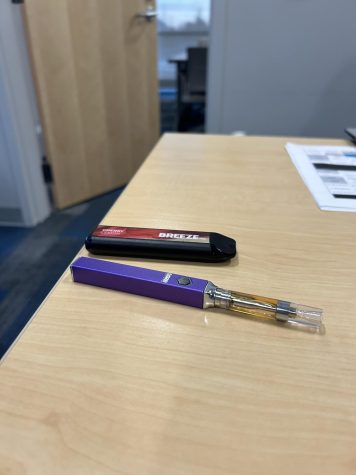Heroin deaths surpass car accident deaths, cause severe addiction after single use
As time progresses, news evolves. When watching the current news, one might learn about the lost Malaysian Flight 370 or the ferry boat accident in South Korea. While these are tragic accidents, they are simply that: accidents. These occurrences are as rare as they are tragic, making them more newsworthy. Accidental deaths caused by drugs such as heroin, however, have become much more common in recent years and have even surpassed car accidents for the leading cause of accidental death nationwide.
Heroin, an illegal opiate drug derived from the opium poppy, has become an increasingly prevalent issue throughout the country. First recognized within the United States in the late 1800s, the highly addictive drug often has long-lasting, detrimental effects. Heroin is produced as a white or beige powder or a black, sticky tar and can be injected, smoked or snorted. Even in places like Bath and Richfield, heroin overdose cases are occurring more frequently than ever before.
Kay Quigley, student assistance coordinator with the Revere Local School District, explained that many heroin addictions stem from the use of prescription painkillers, which share several chemical components with the drug. Quigley acknowledged that even though patients may take the painkillers as prescribed or may have never been involved with drugs in the past, they can still become reliant upon the substances. This accidental addiction can become a gateway to more potent drugs such as heroin.
“A lot of these people started with injuries . . . . The brain just gets hooked on this feeling. [The addiction] is more powerful than anything in the world. [The brain] gets hooked on this feeling and it craves it. The withdrawal is so bad that [the brain] wants it. It is really hard to keep getting prescriptions . . . . That takes a lot of conning and trying to deal with a lot of different doctors and prescriptions. But, it is easy to get heroin. Heroin is about five bucks on the street. You can get the heroin easier. People go from the painkillers to heroin,” Quigley said.
The initial use of heroin creates cravings that can quickly evolve into a full-scale addiction, even after a single use. Michael McNeely, Chief of Police in Bath Township, Ohio, described the addiction process.
“The user needs to increase the euphoric rush created by the initial use of the drug; therefore, the need for the drug requires more frequent use,” McNeely said.
Although the use of heroin declined after its popularity during the Vietnam War era, the drug began to make a resurgence across the country in the 1990s, and the issue has progressively worsened over the last several years. According to McNeely, the increase in heroin usage— and therefore overdoses and deaths— is due in part to the drug’s affordability and the ease with which it can be obtained.
“Unfortunately, heroin is very common across the United States. Thus far, there have been two deaths and several overdoses as a result of heroin use in the Bath-Richfield community,” McNeely said.
When taken, heroin can negatively affect many physical, emotional and mental processes. According to the website www.drugbeat.org, heroin slows down heartbeat and breathing rate, limits rational thought and can lead to severe depression if taken over an extended period of time. Bath Township Fire Chief Walter Hower described some of the effects of heroin that he has encountered while on the job.
“It will lower heart rate and lower respiratory function . . . . Anything foreign could collect in your kidneys. You could become jaundice[d] . . . If the person has any other medical problems, it’s going to complicate those. They can get Hepatitis C if they’re using dirty needles, and we could get stuck with the same thing if we’re not careful. It could cause a whole gambit of problems that you would have to deal with, and most of those don’t have great outcomes,” Hower said.
In addition, dealers occasionally distribute tainted heroin to unknowing users. In November, a bad batch of heroin was released in Lorain County, Ohio, killing three people and causing dozens of others to become ill. McNeely explained that drug dealers try to maximize their profits by diluting the drug with a secondary substance, which can create a bad batch of heroin.
In this particular instance, the dealer mixed the heroin with fentanyl, a synthetic opiate that, according to www.drugabuse.gov, is more potent than morphine. McNeely further described other dangers of using heroin.
“The risk of contracting blood-borne pathogens such as HIV and hepatitis [through] the sharing of needles is primary. There is the risk of contracting bacterial or fungal endocarditis and possibly venous sclerosis abscesses . . . . Physical dependence can result from prolonged use of all opioids, resulting in withdrawal symptoms on cessation of use . . . . A heroin addict is a recovering addict for life. Recreational drug use is a sure way to decrease your personal health and not a means to enhance your thought process,” McNeely said.
Hower explained that first responders can administer a medicine called naloxone, more commonly known as Narcan, which can be used to counteract opioid drugs such as heroin and remove them from the user’s system. Ambulances commonly stock the medicine, and it is administered intravenously, via an injection through the arm or the shinbone, depending on the patient’s condition. If possible, first responders can administer the medicine via a nasal spray, which can prove to be a much more convenient option than those that require the use of needles. However, the medicine can elicit extreme and possibly violent responses from its recipients. Hower discussed the benefits, drawbacks and limitations of the medicine.
“We’ve had circumstances where it’s taken six of us to hold someone down. It [can] create dangerous circumstances. [However,] there are some people that we’ve picked up every weekend for the same problem, and they’re probably not going to make it that much longer. We’re not going to be there in time, or someone’s not going to be there in time,” Hower said.
Hower recalled that when he worked full time he could encounter three cases in one week during his shift alone, and that ten years ago he never thought heroin would be a problem. He described the process that first responders go through when encountering a heroin overdose.
“If they’re not breathing, if their heart isn’t beating, we’re going to start CPR. Your brain needs blood all of the time; in four to six minutes without it, you could be brain dead. We’ll give the person Narcan and epinephrine, which will get your heart moving. If the heart’s rhythm is abnormal, we may have to use an AED (automatic external defibrillator). With that person, we don’t know if their heart gave out, or if they stopped breathing; we don’t know how much of the drug hit what. There are different causes for different things. The scary thing is that the social or economic setting doesn’t matter. It doesn’t matter who you are. Anyone can get hooked, and it’s a shame. It’s hard to stop once you’ve started,” Hower said.
According to the website www.healthy.ohio.gov, Ohio’s death rate due to unintentional drug poisonings increased 335 percent from 1999 to 2009. Also, opiated overdose deaths have surpassed car accidents for the first time in history as the number one cause of death nationwide. Quigley described the thought process students often go through when thinking about drug use or other risky activities.
“Most teenagers think ‘that will never happen to me,’ ‘I am never going to do that’ or ‘I am going to stop.’ I really think that is true for everything else in life except for an addiction. It is a choice at first but once you get hooked it isn’t a choice anymore. I really have a hard time convincing teenagers that after a certain point it is not a choice anymore; it is something that takes over and goes beyond all reason, all knowledge, [and] all willpower. It is really hard to get that into somebody’s head,” Quigley said.
On March 13 Revere High School hosted a CARE adult education program concerning heroin and other opiates. A panel of professionals spoke and several recovering addicts and their families shared their personal experiences related to the drugs. Quigley described the event’s purpose.
“I proposed [the idea] because I want to be on the cutting edge. I have been talking to kids for the last two years about this drug, and they have known people on it and some of them have tried it. I said ‘Now is the time. We have got to get going on this now and we cannot wait any longer.’ We needed to have parents know about this because a parent never thinks their kid is doing a drug,” Quigley said.
Wally Clevenger, member of the Heroin Awareness Team that was at the event on March 31, spoke of the event’s importance.
“We are trying to get [to] the kids before they do [heroin] the first time . . . . The biggest thing is that if you decide to start heroin it will be a long time before you get rid of it,” Clevenger said.
Quigley explained that some telltale signs of drug use include burned spoons or pipes and light-colored dust residue. Those who are doing drugs may also exhibit pinpoint pupils.
Quigley voiced the importance of getting a natural high through playing sports, spending time with friends, observing nature, or doing other fun, drug free activities that do not harm anyone.
“We need to get ‘high,’ we all have that desire. It is just how we go about it. There are so many prices you have to pay for the short time of running away. After aerobics exercise, it is a long-lasting good feeling, and it is not just gone in two hours or something. It makes you feel good in so many ways after that drugs cannot do. Once they are gone and out of your system you hit the bottom again and you have to find a way to pick yourself back up . . . . It is not just the person it is the whole family. You ruin so many lives. Drugs are selfish, it is a selfish disease. Once a person gets hooked they cannot get out of it themselves,” Quigley said.
McNeely added that any person found in connection with heroin will be charged with a variety of felony offenses punishable by imprisonment greater than a year.
Though the drug is quickly increasing in popularity, the truth remains: heroin is an illegal and dangerously addictive drug that can cause serious illness and even death in its users, and present significant hardships and suffering to those around them.










